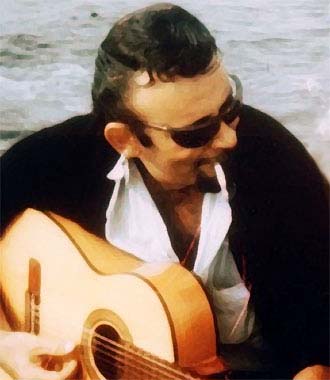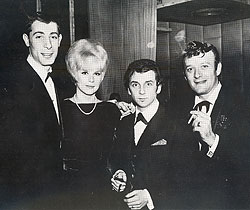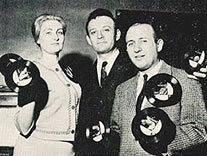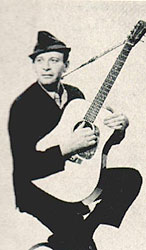EXCLUSIVE PREVIEW:
Long Awaited Biography of Record Man Bert Berns
Here Comes The Night:
The Dark Soul Of Bert Berns and the Dirty Business Of Rhythm and Blues
Joel Selvin |

INTRODUCTION
Bert Berns was one of the great originals of the golden age of rhythm and blues. He prospered and thrived under the auspices of Atlantic Records, a company devoted to authentic, vibrantly musical rhythm and blues records at the forefront of the art form. Under the beneficent encouragement of Atlantic's Jerry Wexler, Berns developed into one of the leading record men of his day. His records with Solomon Burke established the singer as one of the most formidable figures of the rhythm and blues world, shoulder-to-shoulder with peers such as Sam Cooke, James Brown, Jackie Wilson and Ray Charles. He brought the heart of mambo into rock and roll - not the supple Brazilian samba rhythms found in records by Jerry Leiber and Mike Stoller or Burt Bacharach, but fiery Afro-Cuban incantations that pulsed with sex and sin. Almost alone among his contemporaries on the New York scene, Berns traveled to England as his song "Twist and Shout" rose as an anthem to a new generation of British musicians, where he made key records in the country's pop transformation. As he devoted more time to running his own record label, Bang Records, Berns started the careers of future giants Van Morrison and Neil Diamond.
All the time Berns was making records, he was in a hurry. After falling ill with rheumatic fever as a teenager, Berns was told he wouldn't live to see twenty-one. He didn't even make his first record until he was thirty-one years old and, once he started, success couldn't come quick enough for him. He devoured his career. He vaulted from the ranks of the amateur into the highest realms of the world where he walked in less than two years and his ambition never slacked. The ever-present damaged heart drove him relentlessly, as it filled his waking hours with the terror of death, fears he masked with a carefree, happy-go-lucky façade. Tick … tick … tick. Only few intimates knew that Berns was standing on a trap door. It leaked into his songwriting. Other writers could employ the songwriting clichés around hearts without irony, but for Berns, these similes and metaphors were his life. The cries by his singers came from deep within Berns. He carried his doom like a cloud around his shoulders. For Berns to write "take it … take another little piece of my heart" was a plea straight from his life. When his own dark tragedy combined with the pathos of his music, his life took on epic dimensions.
At the end of his life, as the stakes rose sharply and events spiraled out of his control, Berns associated with big time operators in organized crime, both personally and professionally. It caused a fissure in his world, but Berns was comfortable with these men and what they represented. He was a man who needed to take short cuts. Threatened by a fatal catastrophe, surrounded by a world where moral boundaries blurred easily, Berns broke some eggs making omelets. In the end, his inflexible fate collided with his greatest aspirations and their frustration, a cataclysmic denouement of almost operatic grandeur. As long ago as 1976, Ben Fong Torres in Rolling Stone called Berns "one of the great untold stories of rock and roll," but there are a number of reasons why the story of Bert Berns has never been told before.
The performers rather than the creators of this music have been traditionally celebrated. Berns died more than forty years ago and never hired a press agent. Also he made powerful enemies during his lifetime who worked hard to erase his memory and diminish his accomplishments. When I first called Jerry Wexler, the man everybody most associates with Berns' career, and told him I planned to work on this book, Wexler's affable tone disappeared. "I'll tell you this," he said evenly. "I don't know where he's buried, but if I did, I would piss on his grave."
On the other hand, when I told him some time later that I completed some initial chapters, he asked to read them and phoned back almost immediately. "Mesmerizing," he said. That didn't mean he changed his mind about helping with the book. "Hell, no," he said. His own recollection of Berns captured in his published memoirs appears largely cribbed from Charlie Gillett's book on Atlantic Records, "Making Tracks." That was Wexler. What a guy.
The first time I asked him about Berns some twenty years earlier - about the same time Ben Fong Torres wondered aloud about the story and I first wrote a small article about Berns in the Records page of the San Francisco Chronicle - he felt more sentimental. "He was my son," he said.
The name Bert Berns first stood out to me reading Charlie Gillett's landmark history of rock music, "The Sound of the City," where I immediately recognized a common ingredient to the records Berns made that Gillett cited. I spent years looking for his name in the small print on 45 RPM records. Some of his best records were never hits. His music became a passion for me. Occasionally I would run into people who knew him and ask them about the man. Tony Orlando was one - I was following him around for another Chronicle article on the day of his return to performing after a year recovering from a dramatic breakdown, a big day in his life to be sure - and he introduced me to his friend, Brooks Arthur, who came to the Bay Area to spend the day with Tony. Brooks engineered many of Berns' greatest records. I met his daughter, Cassandra Berns, at a performance by Big Brother and the Holding Company in San Francisco in 1994 when Melissa Etheridge was going to sit in with the band and sing three songs as a kind of audition for a film under pre-production at the time on the life of Janis Joplin. The producers had paid a lot of money for the rights to the Berns song, "Piece of My Heart," and were probably even going to use the song's title for the movie. Her brother Brett Berns was sick that night at his hotel room, but when we did finally meet some weeks later, the idea for the book was born in a memorable night playing those old 45s and staying up way too late talking.
|
|
Berns deserves the kind of biography a great film director would have. Todd McCarthy's sweeping account of the life of Howard Hawks was a model. Much of his music has gone unheard since its original release. Many of the details of the process have been lost to time. The participants themselves have difficulty recalling long ago events that did not seem noteworthy to them at the time. "It's like trying to remember wallpaper you hung forty years ago," said Artie Butler, the arranger who made so many of these great records.
Berns' story lies buried under layers of history. A straight-forward biography would leave large parts of the puzzle missing. Berns' life and work can only truly be seen as part of the firmament of the New York music business, extending back nearly a hundred years before Berns joined up. In particular, the New York rhythm and blues world in which he operated was a collaborative creative community, a small pond full of big fish - "We were all characters," said Morris Levy of Roulette Records -- and there is no understanding the life and work of Bert Berns without knowing in detail about Leiber and Stoller, Atlantic Records, Burt Bacharach, Hill and Range, George Goldner and all the others who shaped the music and the times. They were all gears on the same machine pushed up against each other. It is important to give his story the widest possible perspective - all the way back to the very beginning of popular music in America with Stephen Foster - so that the relative moral universe of the music business can be, if not appreciated, at least taken into account. How Max Dreyfus has eluded his place in the history of American music cannot be explained simply by his loathing of personal publicity, but he set standards of greed and intrigue in music publishing that stand to this day. Dreyfus was first pointed out to me by conspiracy theorist Jerry Leiber, who saw the slender, aristocratic fingers of the ASCAP founding member reaching into the grubby world of Elvis Presley and rock and roll.
 |
Jeff Barry, Ellie Greenwich, Phil Spector, Bert Berns at BMI Awards Dinner, 1963. |
|
In the end, Berns' career almost perfectly encapsulated the height of the New York independent record scene. He walked onstage in those days after the emergence of rock and roll where the New York music business utterly dominated the pop music universe. When he died seven turbulent years later, the day was done. Corporations started buying up the few independents still standing. New songwriters and new songs stocked the hit parade. The pop music world turned a page.
These songwriters wrote all these songs expecting them to go up the charts, down the charts and never be heard again. Shakespeare probably felt the same way. But their music never disappeared. These songs became the new standards. They were embedded in the sounds of the Beatles and the Rolling Stones and all who came after. They also turned out to be publishing bonanzas that paid dividends long after the initial recordings ended their lives on the charts. That was never part of the original grift.
Berns wasn't the greatest of the era, although his best work was as good as anybody's. But his unique voice as a songwriter, producer and record man is so deeply ingrained into the fabric of pop music, it has become common parlance. Songs of his such as "Twist and Shout," "Hang On Sloopy" or "Piece Of My Heart" have been covered, quoted, cannibalized, used as salvage parts and recycled so many times, his touch has just dissolved into the literature. His name may be lost, but his music is everywhere.
 |
NEW YORK-Proudly displaying handfuls of the Russell Byrd click, "You'd Better," are (left to right) Byrd's press rep Fran Passman, Byrd, and Byrd's associate, Ray Passman. The cleffer-turned-singer debuted vocally on the Wand waxing. |
|
Like Burt Bacharach and Phil Spector, Berns was a disciple of Leiber and Stoller. They all studied at the feet of the masters. Bacharach turned Leiber and Stoller's baion rhythms into gorgeous, baroque pop. Spector matched the majesty of their symphonic rhythm and blues with cacophonous mulch he borrowed from producer Frank Guida of Norfolk, Virginia, where Guida presided over clattering, blurry, throbbing productions on records by Gary "U.S." Bonds and others he released on his own Legrand Records. Guida was an authentic barbaric primitive and Spector took the basic Leiber and Stoller blueprint and filtered it through that gauzy sensibility to create a truly thunderous sound on his productions with the Crystals, Ronettes and other Philles Records acts. Berns specialized in three-minute r&b grand operas, all emotional drama and gospel fury, always with Arsenio Rodriguez's ritmo diablo insinuating itself in between the lines. He transformed the Leiber and Stoller archetypes into yet another deeply personal scenario.
 |
Russell Byrd |
|
Drawing from the same rich talent pool of songwriters, arrangers, session musicians, engineers and artists, these men made almost entirely different records with the same resources. Berns was the funky one, the street cat, the producer who spoke the musicians' language. He was not a schooled musician like Bacharach, but he could read and write music. As a youth, he studied classical piano and would occasionally return to those pieces, but only for his own private entertainment. He was no virtuoso, but he could get his point across. As a guitarist, he could wring a galloping, signature sound out of his nylon-stringed model that stitches its way through a number of his productions, Berns working both sides of the glass. Like most of his contemporaries, Berns depended on arrangers such as Garry Sherman or Teacho Wiltshire to pencil out his vision, but his records with the same arrangers and sidemen sound distinctly like Bert Berns records and bear little relation to work by the same people with other producers. During his first year in the record business, Berns fumbled around for his voice, but once he found his spiritual link to the mambo and rhythm and blues, he instinctively grew into an auteur, an artist who used personal themes to fashion universal messages.
Berns made fifty-one pop chart singles in seven years; nineteen in 1964, his first year as Atlantic Records staff producer, the same year the Beatles and other British rock acts swept America. He made a lot of records that didn't hit the pop charts, but sold r&b, almost took off regionally, bubbled under and otherwise showed signs of life not registered by the pop charts. He did records that never charted with important artists such as Tammy Montgomery, Wilson Pickett or Patti Labelle and the Bluebelles that rank among their best. He wrote or co-wrote almost all. |
|
|
Berns worked with every major figure in his field at the time. He was closest to Wexler, but Atlantic founding partner Ahmet Ertegun also encouraged Berns. He wrote songs with Leiber and Stoller, one of the few outsiders the pair ever admitted to their songwriting circle. Burt Bacharach and Berns shared two sides of a crucial Gene Pitney single early in their careers and Berns later reworked Bacharach productions with session vocalist Jimmy Radcliffe. Bacharach could be seen playing the piano at parties at Berns' penthouse. Berns' work with Luther Dixon, one of the vastly under-rated producers of the era, created "Twist and Shout" by the Isley Brothers. Phil Spector not only produced the previous, little known first version of Berns' most famous song, but also produced Berns himself as a vocalist named Russell Byrd. With the great Aldon Music songwriting teams - Barry Mann and Cynthia Weil, Carole King and Gerry Goffin - Berns cut important records on their songs. Carole King does not recall meeting Berns - she well remembers his work - but she arranged and played piano on a hit single Berns sang, so they worked in the studio together. Jeff Barry and Ellie Greenwich were not only close friends, and pitched in making records on many Berns sessions, but they brought Berns for his record label their discovery, Neil Diamond. His touch suffused all his collaborations. His enthusiasm could not be contained. He was never a passive co-writer. Even on songs substantially written by Berns co-writer Jerry Ragovoy, Berns stamped his hallmarks all over the numbers, preserving at the same time Ragovoy's voice - funky little touches like the "C'mon, c'mon, c'mon" part in Garnet Mimms' "Cry Baby."
Unlike other characters on the scene, Berns could also write songs by himself. Some of his collaborators, in fact, almost appear invisible in the final mix, as if they served as little more than sounding boards Berns rewarded with half the copyright. He kept at the ready a collection of musical phrases, chord changes and lyric ideas that he switched around willfully, shamelessly, resorting to familiar motifs that he could often open up in surprising and powerful new ways. He took an almost incidental guitar lick from a record he did with r&b vocalist Marv Johnson and turned it into the dramatic, glistening guitar part that anchors his record with British rock group Them, "Here Comes the Night," played by twenty year-old British session musician Jimmy Page. He rewrote the chord changes to "La Bamba" and the unofficial Cuban anthem, "Guantanamera," over and over again, coming up with remarkably fresh approaches to the same basic song structure - from "My Girl Sloopy" to "Piece of My Heart."
His songs entered the literature even during his lifetime. "Twist and Shout" reverberated around the world. His "My Girl Sloopy," recast as "Hang On Sloopy," was a number one hit by the McCoys, in addition to more than fifteen other versions recorded the same year. Janis Joplin did "Piece of My Heart" with Big Brother and the Holding Company less than a year after Berns made the Erma Franklin original. The British Invasion groups all cut Berns songs; Beatles, Rolling Stones, Animals, Yardbirds, many others. When guitarist Jimmy Page recorded the debut album with his new band, the one track the group didn't release from the sessions was a cover of Berns' "Baby Come On Home," which went by the working title "A Tribute to Bert Berns" during those first Led Zeppelin sessions. John Lennon knew who Bert Berns was.
Ellie Greenwich laughed at the idea that they wrote about their own lives. "We wouldn't do that," she said. But, of course, artists have no other experience to draw from but their own and it is an inevitability that even songwriters and producers operating within the most commercial parameters will draw on their own lives. Themes emerge over the course of a body of work. While lyricist Jerry Leiber etched brainy, smart aleck social commentaries and Gerry Goffin continually returned to themes of dreamy aspirations and wish fulfillment, Berns kept reaching for tears. He wanted his singers crying. He pushed vocalists on his records to the brink, trapped in desperation and fraught with urgency. When I asked him about Berns and all the tears, Jeff Barry said that if he kept doing it, it probably was something more than a professional decision. But these songwriters were not self-conscious artists exploring their inner lives. They operated under an industrial mandate. Their music's appeal was designed to sell records; any self-serving "artistic" motives were pointless. Under such strictures, however, these men made magnificent music, these glorious records, filled with imagination, wonder and beauty.
Ellie Greenwich may have allowed herself the luxury of distancing herself emotionally from the teen dramas she and her husband Jeff Barry created such as "Leader of the Pack" or "Chapel of Love," but Berns couldn't. His looming mortality magnified every event, every song, every week's chart positions. This wasn't just music to Berns. This wasn't some high stakes con game for the hip, witty and clever. This was life and death to Berns. To write his desperate songs, to make these singers sing the songs the way he needed them to be sung, to construct these gothic records as temples of sound, to reach deep into his mad Russian heart and wrench loose the pain and fear, Berns peered into his own dark soul for his music. Every song took another piece of his heart.
Literary Agent:
Frank Weimann: fweimann@theliterarygroup.com |
|